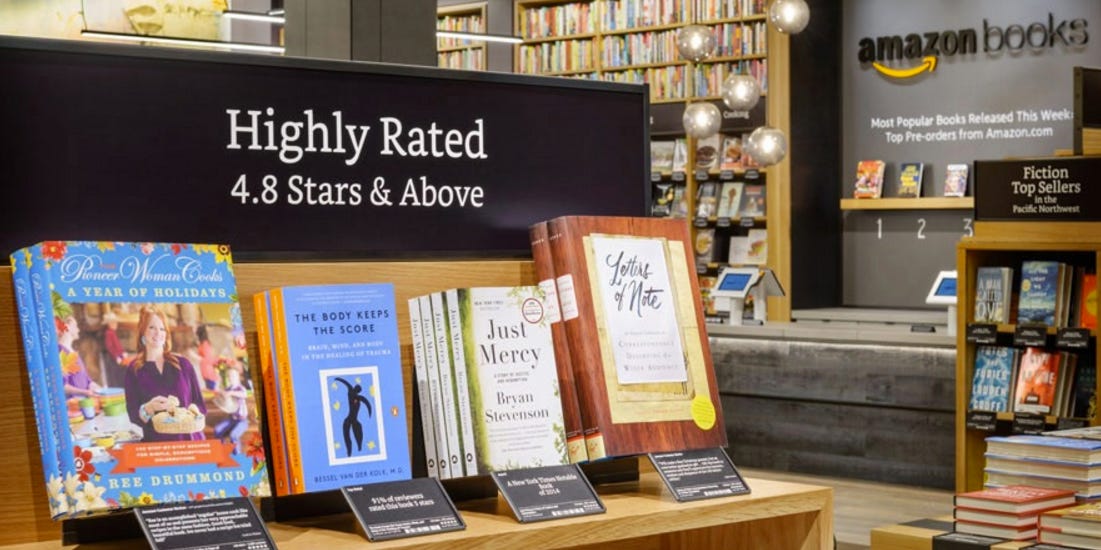- Amazon opened its first physical Amazon Books store in 2015 in Seattle, Washington.
- The stores sold books and other items curated from Amazon’s website. They are now closed.
- Stock was based largely on Amazon analytics, like sales data and customer ratings.
Amazon launched in July 1994, billing itself as “Earth’s Biggest Bookstore.” That was appropriate since the first iteration of the website only sold books, yet it had no brick-and-mortar retail presence.
Even as Amazon expanded its inventory, adding music CDs in 1998 and a broad selection of other products in the following years, the brand remained an online-only retailer.
All that changed in 2015 when Amazon opened its first Amazon Books retail location. The Amazon Books physical store chain operated for seven years but announced in 2022 that all locations would close. The closure is now complete, with all locations permanently shut down. Here is a short history of the chain of physical bookstores once known as Amazon Books.
The first Amazon Books store
Amazon’s first retail location opened in November 2015 in Seattle, Washington — specifically in the University Village shopping center in Seattle’s “U District” near the University of Washington.
Like all other locations that followed, the store was stocked based on the Amazon website’s analytics. Customer ratings, sales data, and Goodreads metrics were primarily used to decide which books appeared on the store shelves.
The first location offered about 5,000 titles, and expanded its inventory to include Kindle ebook readers, devices like Amazon Echo smart speakers, and other consumer electronics also offered on the website.
While a physical Amazon Books store provided a new way to interact with customers — a physical retail space for browsing and purchases outside the brand’s traditional online storefront — it was also a new vector for offering value to Amazon’s lucrative Prime membership. Products in the store had two prices: one for ordinary customers, and a discounted price for Amazon Prime subscribers.
Amazon Books growth
The second Amazon Books location opened in San Diego, California. Subsequent stores appeared in cities like Portland, Oregon; Bellevue, Washington; Chicago, Illinois; Atlanta, Georgia; Century City, California; Paramus, New Jersey; and New York City. In total, Amazon opened two dozen stores across 12 states and Washington, D.C.
At its peak, California was home to the most Amazon Books stores, with seven in total. Several other states tied with two stores each, including Colorado, Massachusetts, New York, Texas, and Washington.
No two Amazon Books stores were identical; each location had a somewhat unique layout and inventory. Even so, they all shared some common characteristics. Locations ranged from 3,500 sq. ft. to 6,000 sq. ft. In addition, all stores relied on the same general retail strategy, with a mix of books and electronic devices for sale, along with a carefully curated selection of other products chosen from the Amazon website’s inventory.
Unlike most bookstores, books at Amazon Books were displayed face out rather than spine out to make them more engaging to customers. Devices like Kindle readers, Amazon Echo speakers, and headphones were on display in demo mode, and customers were encouraged to explore them, much like Apple retail stores.
The end of Amazon Books
On March 2, 2022, Amazon announced that it was closing all of its Amazon Books retail locations., including all 24 permanent locations and a small array of pop-up shops.
The closures were part of a larger belt-tightening at Amazon, where a total of 68 retail stores have been closed in total. Despite the continued success of the Amazon website, sales growth in brick-and-mortar locations had been sluggish, with the company reporting disappointing sales.
In 2021, Amazon’s stock price dramatically underperformed compared to other tech stocks, and this appears to have led to the decision to pivot its retail strategy, cutting costs by closing retail locations.
Amazon has said that it has plans to continue operating other retail stores, focusing on Whole Foods Market, Amazon Fresh, Amazon Go, and Amazon Style stores.
This includes continuing to deploy Amazon’s so-called Just Walk Out technology, which uses various sensors throughout the store to automatically charge customers’ Amazon accounts when they leave the store with merchandise.
Read the full article here





